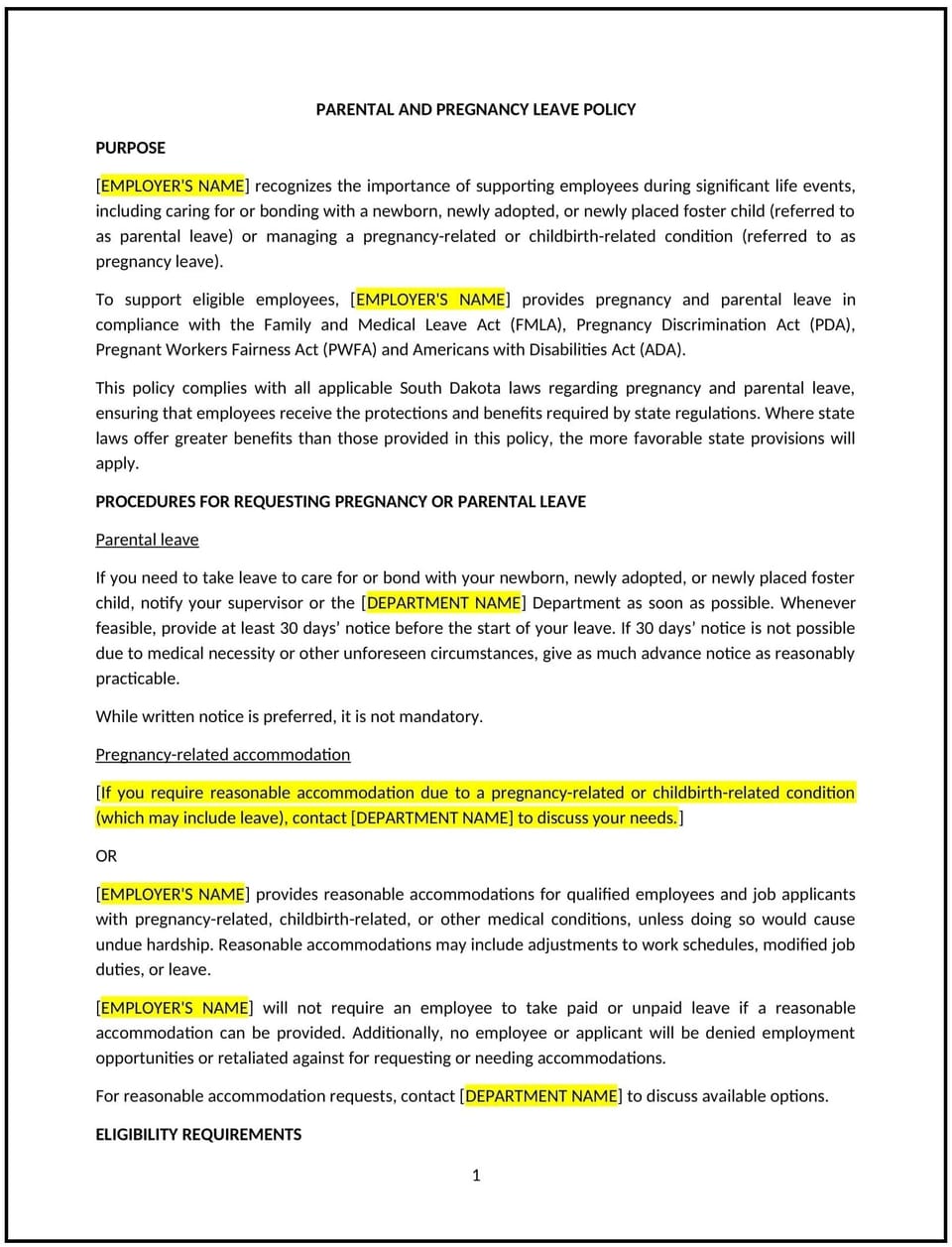Parental and pregnancy leave policy (South Dakota): Free template

Parental and pregnancy leave policy (South Dakota)
This parental and pregnancy leave policy is designed to help South Dakota businesses establish guidelines for employees taking leave for childbirth, adoption, or pregnancy-related needs. It outlines procedures for requesting leave, job protection, and pay during leave.
By adopting this policy, businesses can support employees during significant life events, promote work-life balance, and align with general best practices for leave management.
How to use this parental and pregnancy leave policy (South Dakota)
- Define parental and pregnancy leave: Explain what qualifies for leave, such as childbirth, adoption, or pregnancy-related medical needs.
- Establish eligibility criteria: Specify requirements for employees to qualify for leave, such as length of employment or hours worked.
- Set request procedures: Provide steps for employees to request leave, including required documentation and notice periods.
- Address job protection: Guarantee that employees will return to the same or an equivalent position after leave.
- Specify pay during leave: Outline whether employees will receive regular pay, partial pay, or unpaid leave during parental or pregnancy leave.
- Train managers: Educate supervisors on handling leave requests and maintaining workflow during absences.
- Review and update: Assess the policy annually to ensure it aligns with evolving business needs and workforce expectations.
Benefits of using this parental and pregnancy leave policy (South Dakota)
This policy offers several advantages for South Dakota businesses:
- Supports employees: Demonstrates a commitment to helping employees balance work and family responsibilities.
- Enhances employee satisfaction: Provides job-protected leave, boosting morale and retention.
- Promotes work-life balance: Encourages employees to take time off for family needs, improving overall well-being.
- Builds trust: Shows employees that the business values their personal and family life.
- Supports reputation: Positions the business as a family-friendly and supportive employer in the community.
Tips for using this parental and pregnancy leave policy (South Dakota)
- Communicate the policy: Share the policy with employees and include it in the employee handbook.
- Provide training: Educate managers on handling leave requests and maintaining workflow during absences.
- Monitor implementation: Regularly review leave requests to ensure adherence to the policy.
- Address issues promptly: Take corrective action if leave requests are mishandled or denied improperly.
- Update regularly: Assess the policy annually to ensure it aligns with evolving business needs.
Q: How does this policy benefit businesses?
A: By offering parental and pregnancy leave, businesses can support employees, enhance satisfaction, and promote work-life balance.
Q: What qualifies for parental leave?
A: Parental leave may include childbirth, adoption, or foster care placement, as outlined in the policy.
Q: Can employees take leave for pregnancy-related medical needs?
A: Yes, employees can take leave for pregnancy-related medical needs, such as prenatal care or recovery.
Q: How should businesses handle extended leave requests?
A: Businesses should work with employees to accommodate extended leave while maintaining workflow.
Q: How often should businesses review this policy?
A: Businesses should review the policy annually or as needed to ensure it aligns with evolving business needs.
This article contains general legal information and does not contain legal advice. Cobrief is not a law firm or a substitute for an attorney or law firm. The law is complex and changes often. For legal advice, please ask a lawyer.


